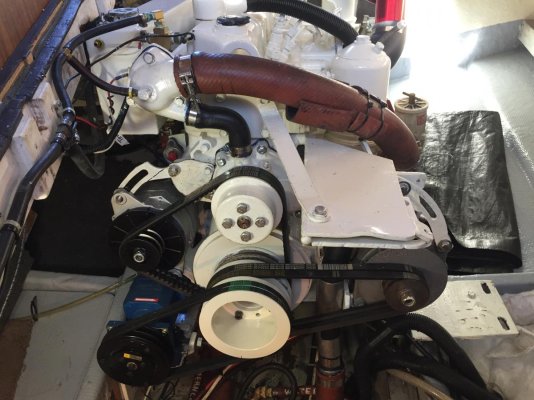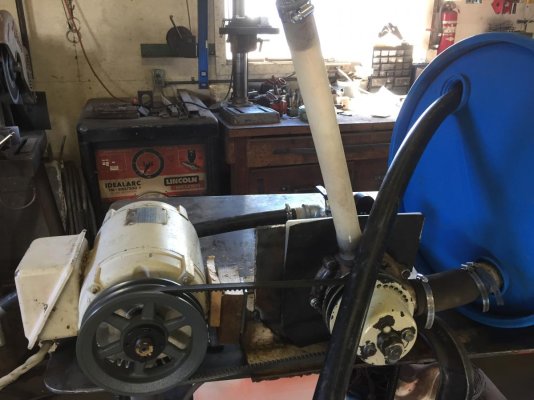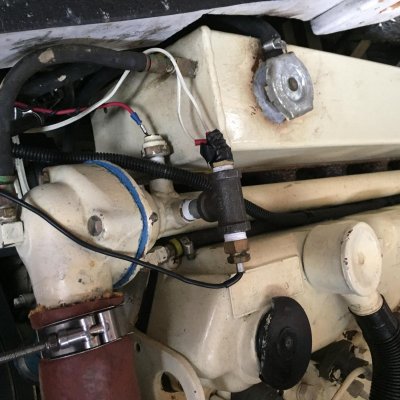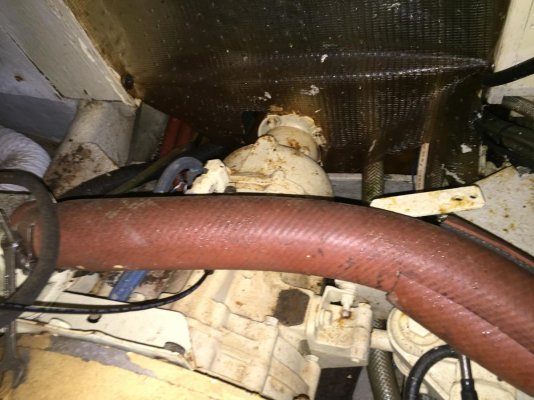Transaxial
Senior Member
I am trying to improve a chronic overheating problem for my old Mitsubishi 6D14. It is 6.5 liters or 400 Cid and na. I bought the boat a year ago and all I really know for sure is the PO had some overheating problems too. It could be rated as continuous power output which would be 115 hp @ 2800 rpm or more likely 126 hp at 2800. That would generate a water jacket heat rejection of 234,000 btu according to the service manual, which I think is 100,000 low, and require a coolant flow of 58 gpm, or more if the 234,000 is low. I have rebuilt the old aluminum water pump which involved aluminum welding the erosion that caused 1/4" gaps between the impeller vanes and the housing, and now machining the gap to be only .020. I set up the pump to test flow and pressure on the welding table and at 2500 rpm and 8 psi it is flowing 70 + gpm. That seems good and is up to specs and would be achieved at 2300 engine rpm. That is what I know. What I don't know starts here. This is a 40 year old engine and no one can even match S/N to get the right water pump so we guessed and it seems like the new pump is way low on output. A flow meter is showing only 10 gpm at 1800 pump rpm. Too low. So we need to try the old rebuilt pump first. Problem is the boat is coming out of the water for annual antifoul, zincs and new transducers for new Simrad system, new hydraulic bow thruster. So my main question is, what does my engine need for a keel cooler? It has run for 40 years with an undersized cooling system the way I see it and I am adding a hydraulic cooler. The local boatyard and mechanics put in a request for sizing to Walter and the 234,000 number right out of the book is what got submitted for a heat rejection figure. But this boat has a dry stack and an exhaust cooler box over the standard truck exhaust manifold and a transmission cooler and a hydraulic cooler. All cooled by the engine antifreeze loop. This is way too much resistance in the flow. If the pressure is increased with an additional pump, to achieve the 60 or 70 gpm required, the velocity spikes up over 12 fpm and off the chart. The desired flow rate is 2 to 8 ft per min. It all points to the fact that I need a dedicated cooler for the engine with about 2" ports and able to handle 250 to 300,000 btu??? The remaining 3 coolers would be handled by the existing 40 ?? Ft of 1 1/4" copper keel cooler and circulated by a Grundfoss 26 99 electric circ pump. It seems to be the only way to get enough total heat out of this boat and keep all the volume and velocity figures in a good range. I have been digging up some of my old diesel engineering text books and a good formula for starters to determine flow in us gpm is total btu divided by 500 x delta T. I realize that delta T depends on water temp you are cruising in and a lot of other factors like flow rate, cooler size, etc. and the factor of 500 is only 450 for antifreeze. Too many variables here without some experience weighing in. If I had just let the marina do its thing, I would have had a cooler sized for just the water jacket heat rejection. The extra coolers that will be adding 200,000 btu were never mentioned in the quote. Can anyone give me some real world experience on this?
Another approach to the total btu produced is to use 7 gallons per hour fuel burned at wot which almost never happens, x 138,000 btu per gallon of diesel which equals 980,000 btu approx. About 33% goes to each of engine coolant, exhaust, and rotary energy. Radiant heat off block also accounts for 7%. Where else would all this heat go? Which approach is correct for sizing this keel cooler?
Another approach to the total btu produced is to use 7 gallons per hour fuel burned at wot which almost never happens, x 138,000 btu per gallon of diesel which equals 980,000 btu approx. About 33% goes to each of engine coolant, exhaust, and rotary energy. Radiant heat off block also accounts for 7%. Where else would all this heat go? Which approach is correct for sizing this keel cooler?





